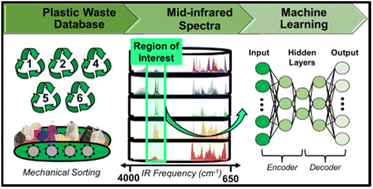Mid-infrared spectroscopy and machine learning for postconsumer plastics recycling†
Abstract
Materials recovery facilities (MRFs) require new automated technologies if growing recycling demands are to be met. Current optical screening devices use visible (VIS) and near-infrared (NIR) wavelengths, frequency ranges that can experience challenges during the characterization of postconsumer plastic waste (PCPW) because of the overly-absorbing spectral bands from dyes and other polymer additives. Technological bottlenecks such as these contribute to 91% of plastic waste never actually being recycled. The mid-infrared (MIR) region has attracted recent attention due to inherent advantages over the VIS and NIR. The fundamental vibrational modes found therein make MIR frequencies promising for high fidelity machine learning (ML) classification. To-date, there are no ML evaluations of extensive MIR spectral datasets reflecting PCPW that would be encountered at MRFs. This study establishes quantifiable metrics, such as model accuracy and prediction time, for classification of a comprehensive MIR database consisting of five PCPW classes that are of economic interest: polyethylene terephthalate (PET #1), high-density polyethylene (HDPE #2), low-density polyethylene (LDPE #4), polypropylene (PP #5), and polystyrene (PS #6). Autoencoders, an unsupervised ML algorithm, were applied to the random forest (RF), k-nearest neighbor (KNN), support vector machine (SVM), and logistic regression (LR) models. The RF model achieved accuracies of 100.0% in both the C–H stretching region (2990–2820 cm−1) and molecular fingerprint region (1500–650 cm−1). The C–H stretching region was found to be free from additives that were responsible for misclassification in other regions, making it a fruitful frequency range for future PCPW sorting technologies. The MIR classification of black plastics and polyethylene PCPW using ML autoencoders was also evaluated for the first time.

- This article is part of the themed collections: Outstanding Papers of 2023 from RSC’s Environmental Science journals, Outstanding Papers 2023 – Environmental Science: Advances and Artificial Intelligence and Machine Learning in Environmental Science


 Please wait while we load your content...
Please wait while we load your content...